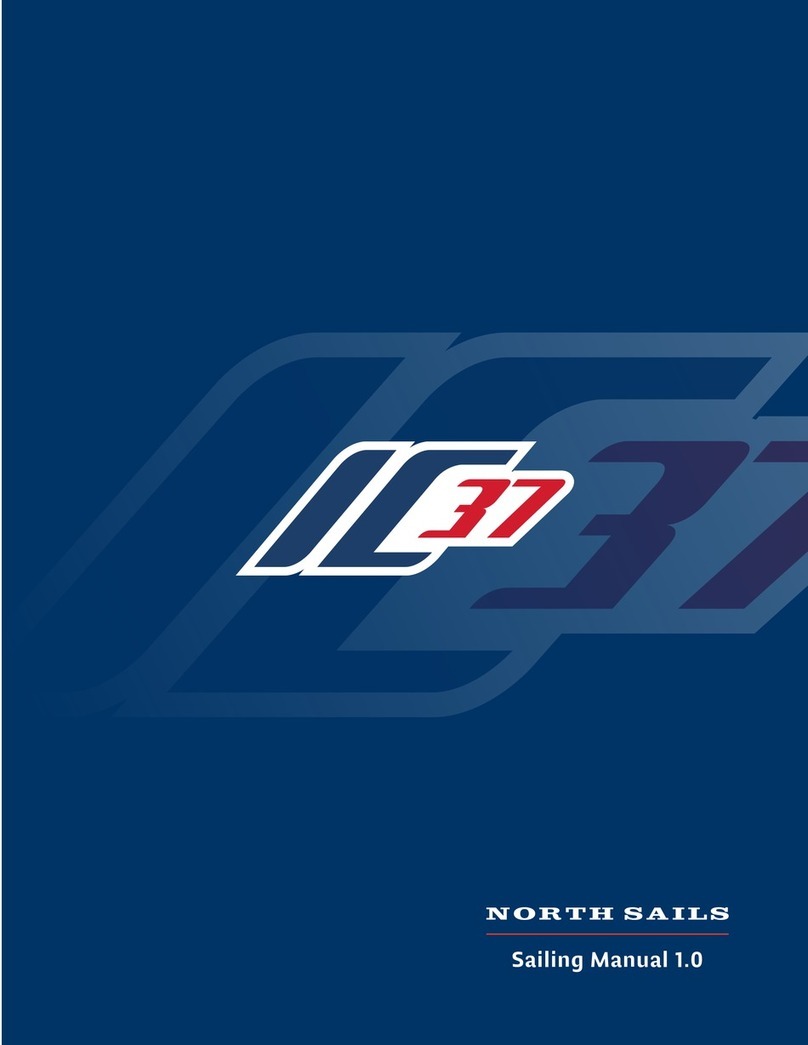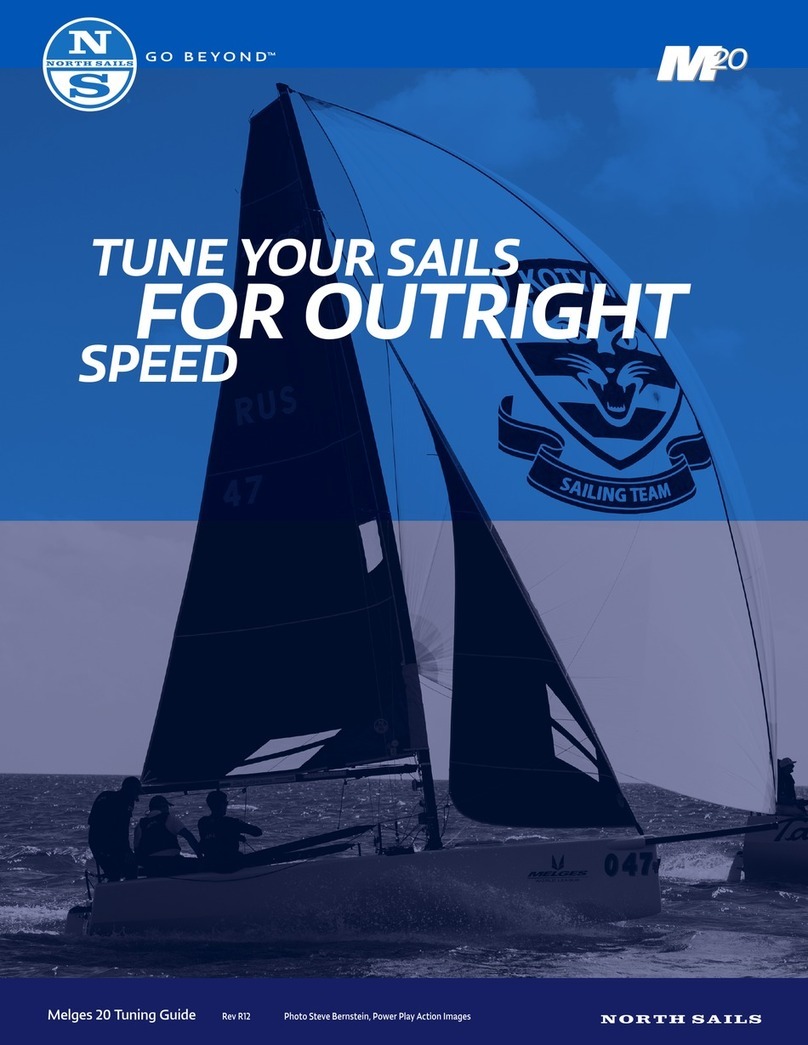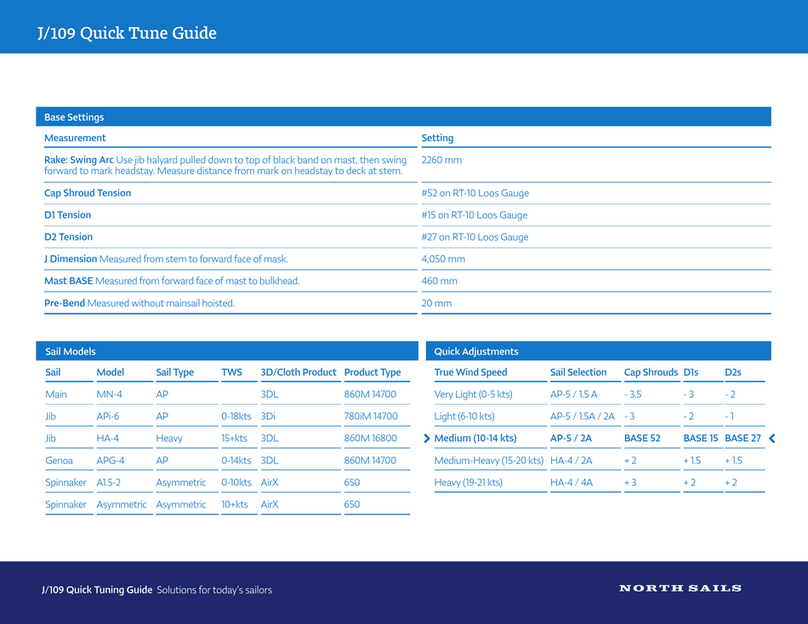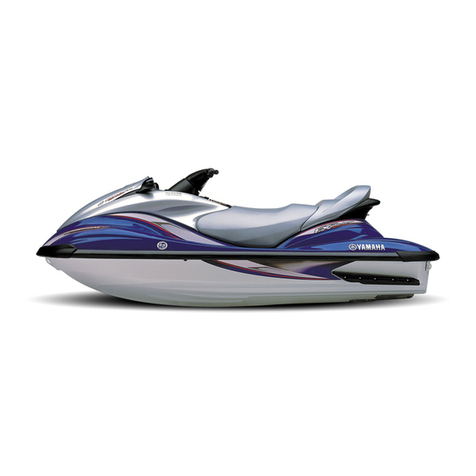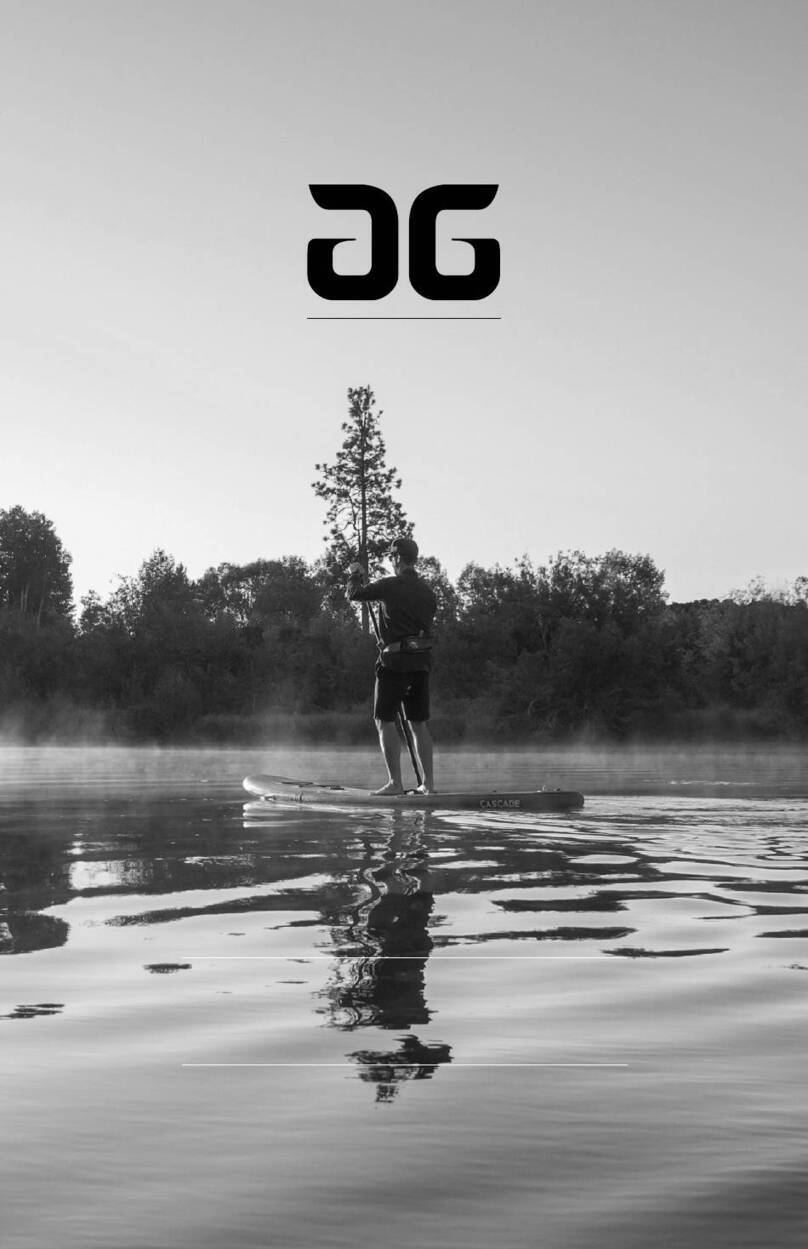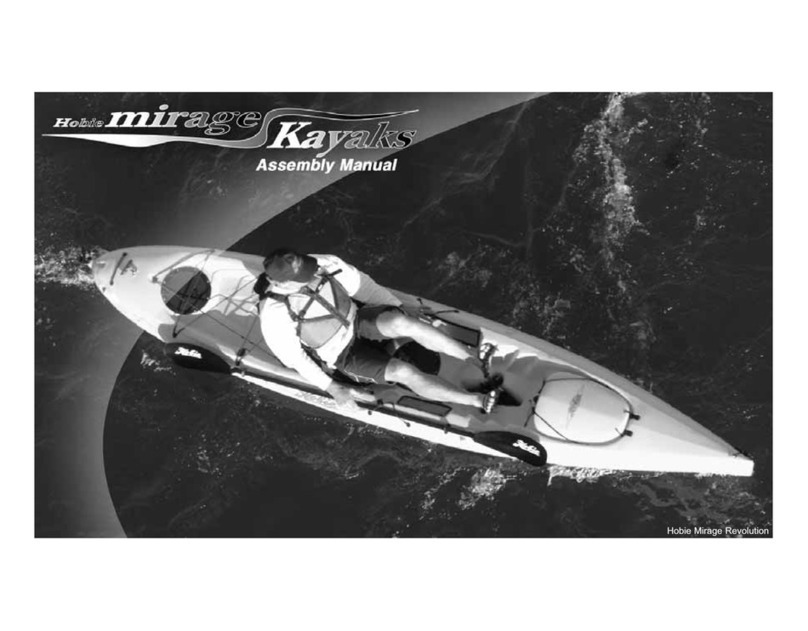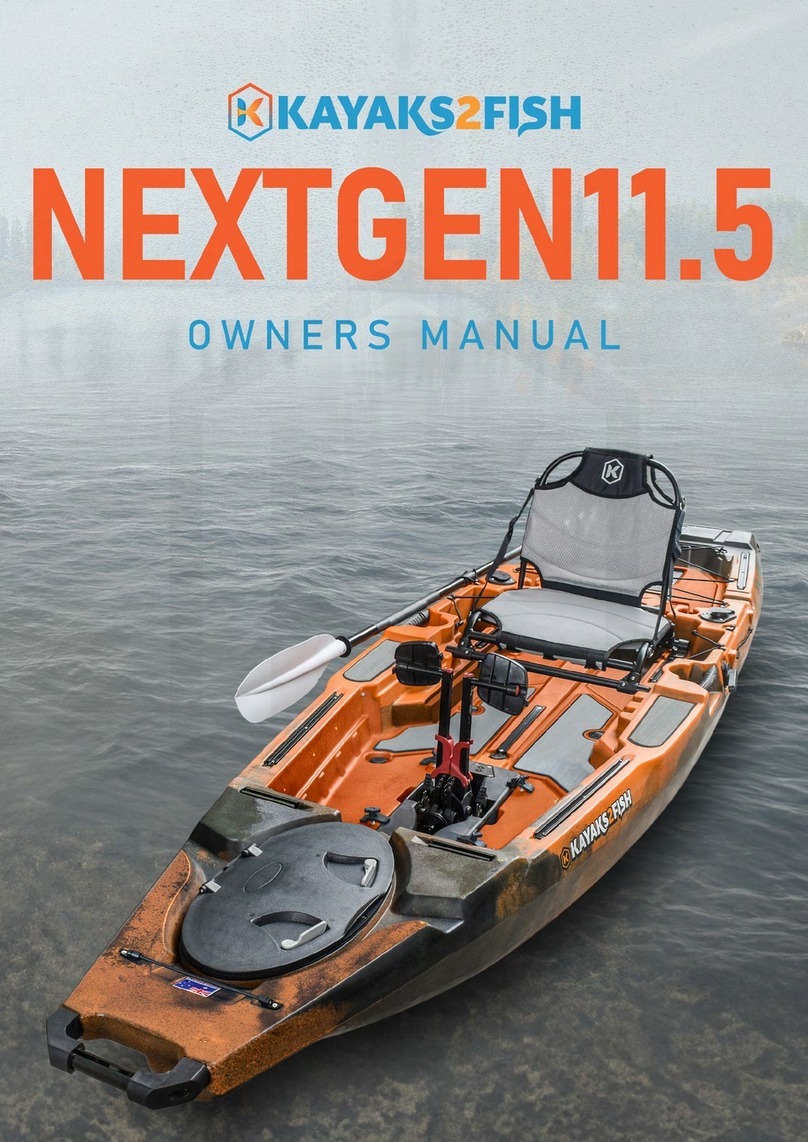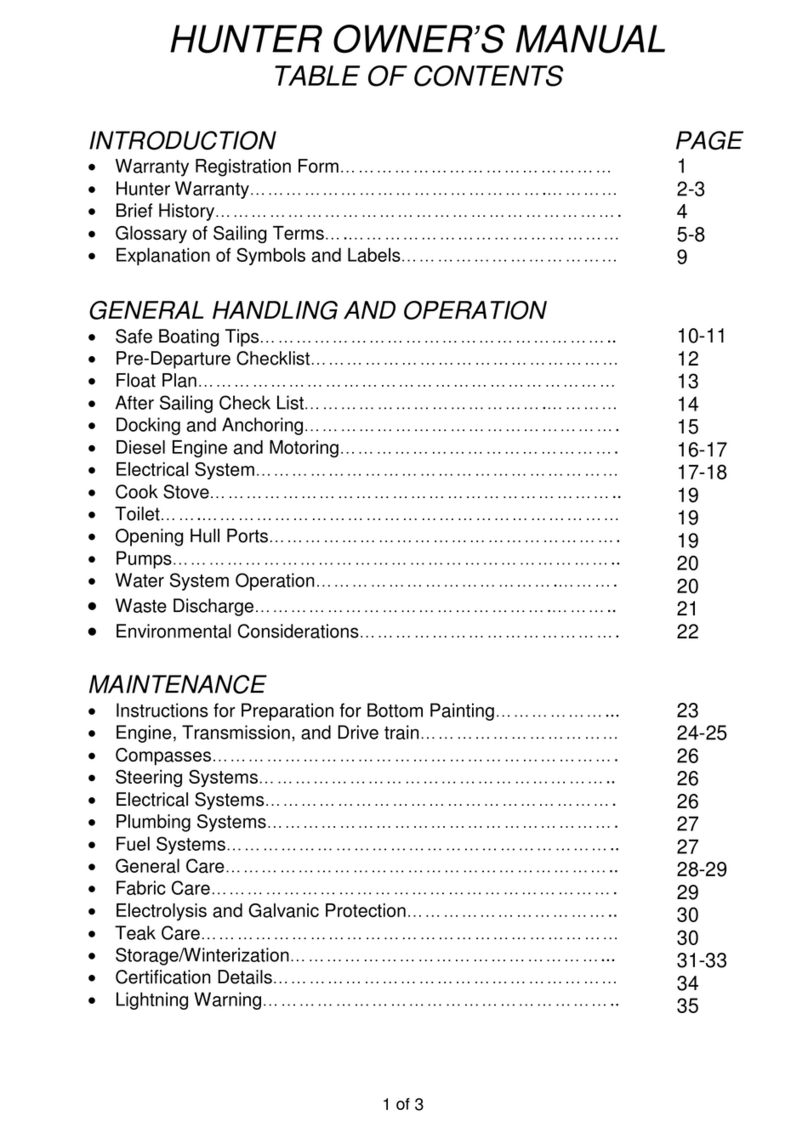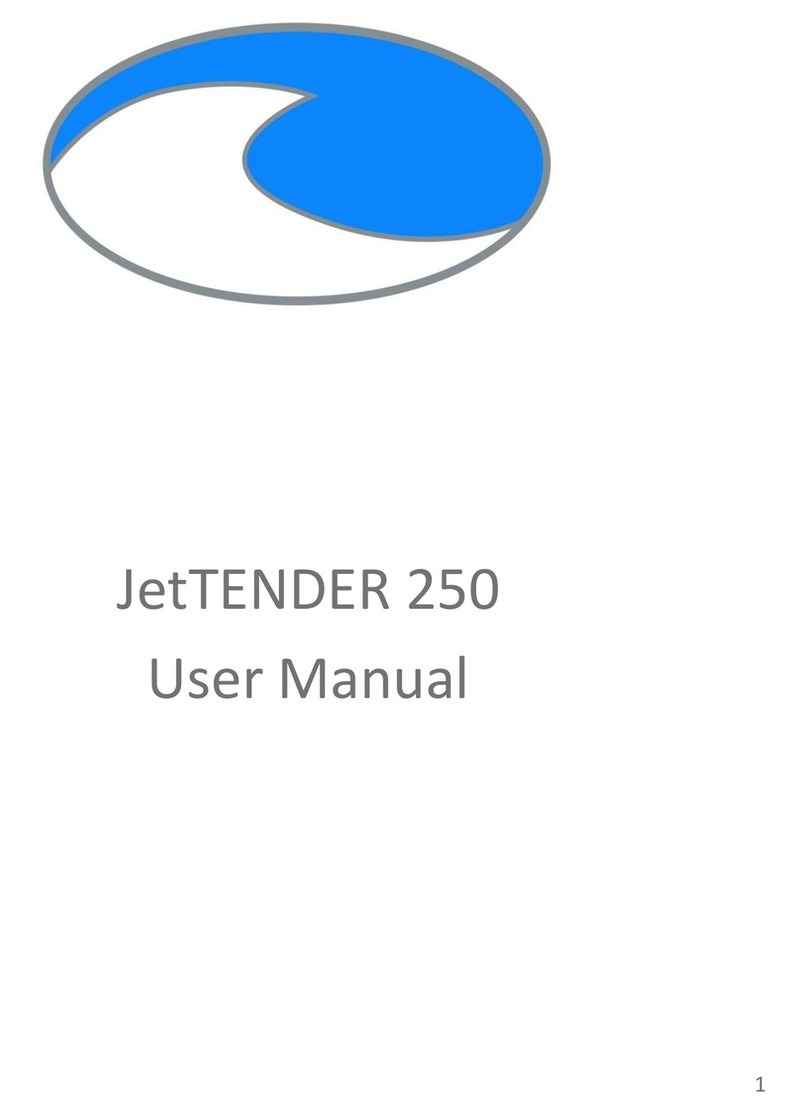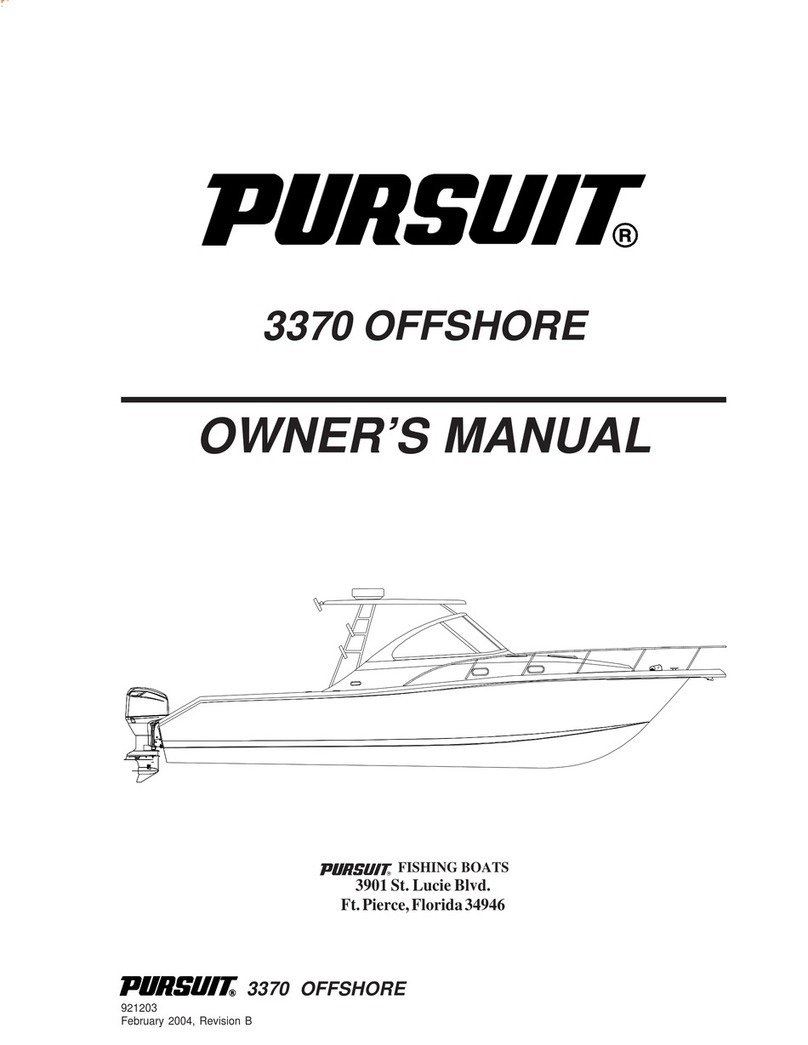NORTH SAILS J/35 Quick start guide

J/35
TUNING
GUIDE
NORTH SAI LS
SOLUTIONS FOR TODAY’S SAILORS
4/00

The original concept of the J/35 developed in 1985 still holds true 15
years later. The J/35 provides excellent one-design racing as well as
casual sailing in the company of friends and family. The ongoing
strength of the class amidst a sea of new one-designs shows an admirable
commitment by sailors in the class. In the popular Sailing World/NOOD
Regattas, the J/35 class continues to have one of the strongest showings.
Race weeks at Key West and Whidbey Island are other top events for the
J/35 class. Today, more than 70% of the boats still actively race –– a
testimony to the enduring success of this design.
Winning ways in one-design racing form the very foundation of North Sails.
By placing knowledge in your hands we all become smarter sailors. Some of
the best and brightest within North Sails have contributed to this guide —
their names are listed with a page of helpful tuning tips on page 18.
We hope you enjoy the presentation of this tuning guide. North personnel
and many cooperative boatowners have invested a lot of time to make this
guide as helpful as possible for you. There are lots of photos showing sail
trim over a wide range of conditions and an overview of the sail inventory.
3DL sails are featured almost exclusively in upwind sails, both for weight
savings and use over a wider wind range. Our comments on sail trim are
written as if we were sailing onboard your boat with you.
As always, we want to know what you think. Call us and let us know if you
have some go-fast tips we haven‘t tried. We hope you enjoy the tuning
guide, and we look forward to another healthy 15 years of racing the J/35!
Tom Whidden, CEO North Sails

J/35 Tuning Guide
Sailplan and deck layout . . . . . . . . . . . . . . . . . . . . . . . . . . . . . . . . . . . . . . . . . . . 4
Setting up the Boat & Rig . . . . . . . . . . . . . . . . . . . . . . . . . . . . . . . . . . . . . . . . . . 5
Going Sailing . . . . . . . . . . . . . . . . . . . . . . . . . . . . . . . . . . . . . . . . . . . . . . . . . . . . 6
Upwind Sailing - Light/Moderate Air . . . . . . . . . . . . . . . . . . . . . . . . . . . . . . . . 7-8
Mainsail Trim . . . . . . . . . . . . . . . . . . . . . . . . . . . . . . . . . . . . . . . . . . . . . . . . . . . . 9
The Trimmers View –– Moderate Air. . . . . . . . . . . . . . . . . . . . . . . . . . . . . . . . . . 10
The Trimmers View –– Heavy Air . . . . . . . . . . . . . . . . . . . . . . . . . . . . . . . . . . . . 11
Speed Tips for Heavy Air. . . . . . . . . . . . . . . . . . . . . . . . . . . . . . . . . . . . . . . . . . . 12
Upwind Sail Settings . . . . . . . . . . . . . . . . . . . . . . . . . . . . . . . . . . . . . . . . . . . . . 13
Spinnaker Trim - Light/Moderate Air . . . . . . . . . . . . . . . . . . . . . . . . . . . . . . . 14-15
Spinnaker Handling . . . . . . . . . . . . . . . . . . . . . . . . . . . . . . . . . . . . . . . . . . . . . . 16
Sail Inventory Notes . . . . . . . . . . . . . . . . . . . . . . . . . . . . . . . . . . . . . . . . . . . . . . 17
Tips & Techniques. . . . . . . . . . . . . . . . . . . . . . . . . . . . . . . . . . . . . . . . . . . . . . . . 18
Sail Care & Maintenance . . . . . . . . . . . . . . . . . . . . . . . . . . . . . . . . . . . . . . . . . . 19
Sales & Service. . . . . . . . . . . . . . . . . . . . . . . . . . . . . . . . . . . . . . . . . . . . . . . . . . 20
Boat Notes . . . . . . . . . . . . . . . . . . . . . . . . . . . . . . . . . . . . . . . . . . . . . . . . . . 21-23
Thanks to the J/35 “Test Team” of (l to r) Andreas Josenhans, Sharon
Benton, Jody Lutz, Matthew Hirsch, Tom and Cindy Hirsch (owners of
J/35 AIRBORNE ) and Jeff Heath. Thanks also to Perry Lewis of North
Sails Midwest and John Gladstone of North Sails San Diego.
TABLE OF CONTENTS

RACING PREP
Race with a SMOOTH bottom!
Fair the keel to make it symmetri-
cal with a perfect trailing edge.
Speedo paddle wheel should be
3-4 feet ahead of the forward
point of the keel at the root.
Stow all gear within two feet of
the mast. Only bring what you
need, leave the rest ashore.
If you are required to carry a raft,
position it to be sure you can get
it topside in 15 seconds (or less).
Don‘t adjust any ballast after
2100 the night before racing.
(IYRU rule 22.2)
2:1 traveler control, 5:1 mainsheet
with 2:1 fine-tune for easier
adjustments upwind.
Mount primary winches even with
forward edge of cockpit to prevent
overrides. (Try using a sissy bar.)
Genoa lead track, car, block
should be low profile with a ratch-
et block and 3:1 puller.
Move the secondary winches, hal-
yard jammers and pole lift cleat
aft to either side of the compan-
ionway to clear off the cabin top.
This helps the crew get across the
deck faster when tacking.
J/35 Tuning Guide
4
SAILPLAN and DECK LAYOUT
to CL of pin at masthead
- top end of forestay
to CL of pin at
stemhead
Secondary winches on cabin top
with controls for lead puller,
twing, foreguy, & cunningham.
Sawed-off tiller with telescoping
extension.The helmsman should be
able to move between the traveler &
tiller without getting hit by the boom.
48'11"

Rig Tension
(# of turns past hand-tight)
CAPS ..................18.0 turns
D1s ...................... 4.0 turns
D2s ......................Hand tight
This is a good baseline tension which
optimizes speed and shape for a
Headstay length —Headstay should
be 48’11”from centerline of the pin
passing through the upper mast tang
to the centerline pin of the tang at
the bottom of the headstay (see pho-
tos at right). The headstay should be
adjusted according to increases in
wind speed. The range setting from
light air to heavy air is 2”.
Centering the spar —Center the
spar with the main halyard to the cap
shrouds. The mast should be placed
14’8”from the stem sheer line to the
front face of the mast.
Mast butt location —Move the
mast collar max-aft. The mast butt
should be max-forward to produce
1.5”of pre-bend. This opens the slot
between the main and genoa making
it easier to generate more tension on
the headstay with the limited amount
of backstay adjustment permitted by
the class. Be sure to lubricate the step
and bolts.
Tensioning the Shrouds —Install
the cap shroud on the aft outside hole,
the lower diagonal shroud (D1) on the
forward hole, and the diagonal shroud
(D2) on the inside hole (see photo) .
Since we want to encourage the mast
to bend forward down low, we put the
D1 on the forward hole. We put the
cap shroud on the aft hole to help
keep it as tight as possible. Once hand
tightened, add the following number
of turns to the verticals and diagonals.
For tuning purposes, tie the shrouds
together before you go sailing, which
allows easy adjustment. Once final
adjustments are made, be sure to pin
the shrouds and tape generously to
avoid chafe.
J/35 Tuning Guide
5
SETTING UP THE RIG
headstay length of 48’11”in a wind
strength of 0-6 knots true. In 7-12,
shorten the headstay to 48’10”.For
wind speeds over 12 true, shorten the
headstay to 48’9.5”.
Mastbend —Five factors control
bend; Backstay tension, runner load,
prebend or headstay length, mast butt
position and finally partner hole
position. What happens when we
change any of the five factors? For
example, if we:
a) Make the headstay 1” longer
- we are adding prebend which
flattens the main in the lower-half
and softens the headstay.
b) Pull the runner/checkstay -
total bend is reduced, the headstay is
tightened, and the mainsail gets
deeper.
c) Move the butt aft - we add
prebend.
d) Bend the mast with backstay
tension - bending increases
headstay tension. This flattens both
sails and moves the draft aft.
CAP
D1
D2

6
The information contained on the
sticker has been developed based on
laminate testing, yarn modulus and
density. This information does not
provide any safety factor. Remember,
wind force increases at a rate of the
windspeed3. When your sails are
used within their designed wind
range, you will maintain the designed
shape longer, which translates into
more fast races.
All North sails include an adhesive
backed sticker applied at the clew.
This contains critical structural redline
information. If the sail is used outside
the posted zone, there is a significant
likelihood of permanent damage.
AIRBORNE sailing in 14 true. Mainsail is hoisted to the black band, and the
genoa lead is perfect, allowing the sail to be trimmed in next to the chainplate
and top spreader. 3DL sails are designed to optimize wind ranges, in the J/35
class with two headsails permitted, range is paramount. It‘s also critical to sail
with the halyard taut to prevent mid-leech sag. We recommend a large diame-
ter uncovered 3/8”(core) Vectran or T900 for a centerline halyard. Halyard
stretch accounts for much range robbing mid-leech sag. Equip your boat with a
good halyard to get the best out of your 3DL sails.
GOING SAILING
J/35 Tuning Guide

7
Sailing toward the Newport Bridge in 14
true and smooth water. The main is
trimmed perfectly with the boom on
centerline and top batten parallel to the
boom. The genoa is at the top of its
range just touching the chainplates and
approximately 2”off the top spreader.
The heel angle is shown by the bridge
abuttment. This is a little too much for
the highest pointing angle, but good for
optimum VMG , especially without any
other boat on the lee bow. With a boat
on your lee bow, 18°of heel angle will
be better.
UPWIND SAILING - LIGHT/MODERATE AIR
AIRBORNE (right) is sailing with optimum heel angle for the
best VMG. In a fleet start and close quarters it will pay to
point higher, trim the sails in harder and reduce the heeling
angle. NOTE: The nice, light touch on the helm. Cindy Hirsch
(owner) steers with minimal tiller motion and is looking for-
ward at the open water between the hiking crew and the
mast. Her focus must be well in front of the bow to see waves
and puffs early enough to respond.
HIKE! The difference between sitting
and hiking on a J/35 is just under
1000 ft./lbs. IF you are hiking hard,
and feel this isn’t contributing to
anything except a sore butt, here‘s a
short list of the positives of hiking.
Allows harder sheeting... more point-
ing, will cause the keel to be deep-
er...more pointing, less pitching...
more pointing and less rudder angle
which contributes to more speed
and.... you guessed it, more pointing.
So when you‘re out on the rail,
encourage your crewmembers to
HIKE! First to finish means first back
to the dock for all the shoreside fun.
25°
J/35 Tuning Guide
20°
HEELING ANGLE

J/35 Tuning Guide
8
UPWIND SAILING - LIGHT/MODERATE AIR
155% Medium #1
Genoa 8820 dpi
(high modulus
Kevlar)
Range is 0-15 (14
true). The mid-
leech at the top of
the range is 6”
away from the
lower spreader.
AIRBORNE is showing good fore and
aft trim sailing upwind in 14 knots
true wind speed in flat water. Heeling
angle, crew placement and hiking are
crucial for speed-building. The first
crew should sit just aft of the
chainplate, with the rest hiking
cheek-to-cheek. Here are some other
fast notes based on this set-up:
Genoa Trim
Touching chainplate, leech is 4”
away from the top spreader.
Mainsheet tension sufficient to
bring the top batten parallel to the
boom, or 2°open, since boom is 6”
below centerline.
Checkstay tension to position
draft ahead of center - this equals
just under 1000 lbs.
Mastbend curve is even.
Cunningham tensioned to carry
only a few 1’wrinkles from the
bottom 1/4 to the tack.
Steering to 4th telltale (4th gear)
This is what FAST looks like.
Headstay - 48’10-1/2”
Backstay - 3200 lbs.
Outhaul- Tight
True Wind Speed =14 knots
TWS 14 knots True
Top 17% @ 44%
Middle 14.3% @ 39%

9
MAINSAIL TRIM
Perry Lewis, (l), of North Sails
Midwest with Bob Alice, (r), owner of
J/35 MIST APPROACH reviewing
Bob‘s onboard sail log and racing
notes. Keeping a photo log of your
sails will provide you with a
“sailmakers eye”for trim, shape,
draft position, mast bend, rig tension
and headstay sag which helps to
repeat fast settings. A log is a great
motivational tool to keep the crew
involved, especially when gearing up
for the new sailing season.
Maintaining a log is especially
helpful to your sailmaker when
evaluating your sail inventory. Notes
on wind speed, wind angle, number
of hours and your comments are just
a few suggestions of items to
include.
On the next page are photos of the
mainsail and genoa taken from“the
trimmers view”to give you an eye for
max speed set-up. Your North
sailmaker can show you how to
measure chord depth and draft
location of sail photos taken from the
correct angle. In most cases, a
disposable camera kept onboard is
sufficient for all the pictures you
need to keep a sail log.
3DL 12600 dpi set-up for 12 true, flat water at the Newport NOOD Regatta.
The sail is sheeted very hard for highest pointing angle. All telltales are flying
and there is no backwinding present.
The same mainsail as above, but note the backwinding. This is caused by two
things; genoa trim and traveler position. In this photo, the genoa is sheeted
extremely hard. The backwinding is not hurting performance...yet. You can
minimize the backwinding by setting-up the mainsail flatter with the traveler
positioned high. The top batten is beyond parallel by two degrees. Tighter
headsail trim minimizes the slot and reduces twist. As a result, the sail sets
straighter vertically, without closing the leech and applying the ‘air brake’.Try
this in 8-14k true, no chop, no pitching. And don‘t forget to hike hard!
J/35 Tuning Guide
TWS 12 knots True
Top 15% @ 44%
Middle 11.9% @ 52%
Bottom 8% @ 49.6%
TWS 12 knots True
Top 14.3% @ 52%
Middle 12% @ 51%
Bottom 8% @ 53.6%

J/35 Tuning Guide
10
SAIL TRIM - LIGHT / MODERATE AIR
155% Medium #1 onboard
AIRBORNE in 15 knots true. Here‘s a
look at the leading edge of the sail
from the feeder back to the sail num-
bers. The telltales are installed in a row
in order to provide a guide when steer-
ing in 1st, 2nd, or 3rd gear. This sail is
at maximum loading for the denier per
inch (dpi). Even at full load, you can see
minimal vertical curvature or “sag”
away from the rig.
155% Medium #1 genoa at the Newport NOOD Regatta. The top spreader is
creating a dimple, but is not hurting the sail. As long as the pressure is occurring
in the middle of the patch, it‘s O.K, but not recommended. Onboard Tom
Harrington‘s OBSTREPEROUS, this sail was instrumental for upwind speed, and
was a key to their J/35 N.A. victory. This sail is sheeted hard for flat water and
max headstay tension. This is the same design as the sail shown on page 8.
GENOA TRIM - MODERATE AIR
Fatal Attraction’s Dacron mainsail powered up in 8 knots true. These numbers
are too deep for a generic sail, but it sure works on a J/35. This sail is set-up
perfectly for lighter wind. Sail trimmers are speed doctors...they can adjust boat
speed through varying conditions - a good mainsail trimmer knows how the
boat will perform in a wide range of wind and sea conditions and knows what
adjustments are necessary to achieve the best shape for pointing, heel angle,
speed and power.
TWS 8 knots True
Top 12.9% @ 31%
Middle 16.5% @ 40%
Bottom 12.0% @ 36.9%
TWS 12 knots True
Top 14.7% @ 43.6%
Middle 14.3% @ 39.1%
Distance from bottom spreader - 3”

11
THE TRIMMERS VIEW - #3 JIB - HEAVY AIR
Left and below are two views of a
three year-old 103% #3 jib in 24
knots true. We don‘t normally choose
to sail in this much breeze for a tun-
ing session, but this sail is function-
ing perfectly. The top stripe is twisted
approximately 15 degrees off the
centerline. The leech is clean and
open and the luff telltales from 1/4
to 1/2 to 3/4 are tipped upward pro-
gressively. The sail construction is not
today’s North “state of the art,”yet
the shape still delivers the goods. We
also like this sail for its straight, flat
exit from the leech which helps mini-
mize mainsail backwinding. The bot-
tom half is nice and flat which allows
the helmsman to steer in high point
mode. The knuckled entry provides
power when needed, especially in
really big waves. A sailmaker sitting
to leeward trimming this sail,might
think “Wow, there is minimal curva-
ture from 20% of the chord length to
the leech.”( Translation: Nice shape,
feels fast, good power.)
J/35 Tuning Guide
Another test of a good #3 is, how
close does the sail fly in front of the
spreaders? The set-up of this sail is
perfect; the halyard is taut and the
lead position is set to allow the top
chord to twist while keeping the bot-
tom half relatively flat. The high-
aspect ratio of the #3 (4.0 vs. 2.21
for the M#1) places a premium on
sheet tension. The difference
between blistering fast in 22 true
and unbearably slow can be as little
as 1.5”on the sheet. Try setting-up
your #3 like the pictures and make
small sheet adjustments to keep you
in the fast groove for the sea state.

12
J/35 Tuning Guide
SPEED TIPS FOR HEAVY AIR
RUNNER & VANG
The use of boom vang in heavy air
(over 18 true) comes very naturally to
some sailors and raises objections
among others. Here is why it works
on a J/35. The downforce generated
on the leech allows mainsheet play
with less resistance. When you use
the vang, you bend the spar forward.
In breeze over 18, we suggest you
shorten the headstay to 48’-10”or
9.5m. This eliminates prebend and
creates the impression the main has
too much low luff curve. The vang
adds just enough mastbend to fair
the mastbend curve back to the
original design.
North 3DL Mainsail 12600 dpi in 24k True (29k approx.) This sail is handling
the loads nicely. The top is flat, open and twisted. The draft is located forward in
the bottom half of the sail, and not too far aft up top. Cunningham is loaded to
position the draft. The vang is aggressively loaded with 100 lbs. (with feet
braced, use both hands!) on the tail of the purchase system. The most
critical element is sheet tension.
A good rule of thumb is to sheet the sail harder until the boat heels too much,
or has too much helm. When this occurs, flatten the sail and move the draft for-
ward. The old rule of when in doubt, let it out may be O.K. Since this makes the
sail less powerful, you may want to adjust other shape controls first, then ease
the sheet as little as necessary.
Small speed gains generate big wins,
especially when sailing in heavy air.
The 3DL mainsail (at left) is nicely
powered up, showing a clean leech
with linear twist from the boom to
the head. Tensioning the checkstay or
runner on the J/35 produces exactly
the opposite sail adjustment com-
pared to a fractional rig. When you
tighten the runner, the mast becomes
straighter. Mastbend flattens the
main, added runner deepens it.
The best way to get this right is to
bend the mast with the hydraulic
backstay, then add checkstay/runner
until the sail is shaped right for the
conditions. The desired sail shape has
the draft ahead of center. Do this by
juggling cunningham and checkstay
load. Don‘t forget to pull the outhaul
to the black band. In wind speeds
above 18 true, take-up 3 turns on the
D2s, and 2 turns on the D1s.
Using Vang in Heavy Air

13
J/35 UPWIND SAIL SETTINGS
MAINSAIL
Backstay
Outhaul
Boom
Position
Cunningham
Vang
HEADSAIL
Headstay
Halyard
Genoa leads
Top Spreader/
Shroud Base
Headsail
Choice
Very Soft
NONE
NONE
Max. length-48’-11”
Eased with small
wrinkles
Top 5”to 8”
Base 6”to 8”
Class / 155%
Medium #1 or AP1
Class / 155%
Medium #1 or AP1
Class / 150% Genoa
or AP1
Class / #3
Top 3”to 0”
Base 4”to 0”Top 0”to 12”
Base Touching base 2nd batten down is
parallel to centerline
for #3 Jib
Eased with small
wrinkles Firm - No wrinkles Firm - No wrinkles
48’-10”48’-9.5”48’-9.0”
NONE Slack removed Aggressive for vang
sheeting
Remove 50% of
wrinkles
Remove all wrinkles Remove all wrinkles
plus 1”
Eased 1.5”from
black band.
Eased 1”from black
band Eased .5”from black
band
Maximum
Centerline 3”above centerline
to even with center-
line
Centerline to 4”
below centerline
Amount of helm dic-
tates location
Boom 6”and
below centerline
Helm dictates exact
location
800 to 2000 psi 2100 to 4200 psi 3100 to 4200 psi
0-6 kts true 7-12 kts true 13-19 kts true 20+ kts true
J/35 Tuning Guide
Checkstay
Tension - %
Heel Angle
NONE Increasing 0-50%
deep draft to
standard draft.
50%-90%
Standard draft 90%-100% keeping
draft standard rela-
tive to backstay ten-
sion
10°- 12°5°- 10°max 15°- 18°max 20°- 22°max
Crew weight
Distribution
Low - Dogs in house
and forward Forward, sitting close
together hiking hard
enough to flatten
boat.
Hiking Hard Hiking even Harder!
TRUE WIND SPEED

Spinnaker trimming is an art which is improved by the level of concentration of
the trimmer. After a really fast downwind leg, the best trimmers will say they
didn’t see anything that happened on that leg. Sailing in these conditions, the
pole height should be set to generate a 4”to 6”curl - short enough to be con-
trollable and long enough to let the sail breathe. Once the pole height suits the
trimmer, pull the leech down hard with the twing to make the leech mirror the
luff. If you are not sure when to twing, look back at a competitors sail and look
for asymmetry. Also, make sure the
boat isn’t heeling, and watch the
speed carefully. When sailing dead
downwind, heel the boat to wind-
ward and keep the weight forward,
just like light air.
If you are reaching, the .75 oz.
does a great job. Move your crew
weight back to control heel and keep
the rudder immersed, and pull the
pole back as far as possible, but
don’t let the lower part of the spin-
naker luff sag aft and to leeward.
Adjust the power with the mainsheet
and vang tension, and try to keep a
slight windward helm.
J/35 Tuning Guide
14
SPINNAKER TRIM - LIGHT/MODERATE AIR
Running in 12 knots true (6 appar-
ent). The driver has a clear view of
the water ahead - important for
keeping the boat up to speed down-
wind, avoiding kelp, and staying in
sync with wind variations and the
cause and effect of tiny steering
changes.
The clews are even height, but to
maintain sailing at the best VMG, the
set-up could be improved by;
Squaring the pole until the luff
rises vertically to fly with maxi-
mum projection and balance.
Extremely critical in light air.
Pulling the twing will make the
cross-section at the radial
head/belly joining seam more
symmetric. This reduces some of
the lost energy being vented at
the leech. This works best in con-
junction with weather heel.
The inboard end of the
pole could be raised
approx. 12”which will
push the outboard end
away from the mast and
project more sail area.
Onboard AIRBORNE flying a .6 Polyester spinnaker in 12 true (left and below).
The spotter looking aft from below the boom is in the best position to see the
puffs tracking toward the boat from astern. The communication from the spot-
ter to the driver is critical. The discussion might go like this,“Puff is six lengths
back and will track 1.5 lengths to weather. How about going up 5°and catch-
ing it?”.Or,“Now we are in the puff, let‘s bear away 5°to stay in the puff.”

15
SPINNAKER TRIM - Judging the curl...
J/35 Tuning Guide
.6 Polyester in 14 knots true
The photos (above and right) highlight the trimmers view of the spinnaker. Jody
(at left) is trimming the spinnaker - gauging luff curl as one of his trim indica-
tors. When sailing in VMG mode, the spinnaker luff should fly vertically off the
pole–in this case the pole could go forward by 1’. In the photo (above left), you
can see the luff rising vertically from the pole and the amount of curl. This is the
max amount of curl since any more would cause the spinnaker to rollerfurl
away some speed. In the photo (right) the curl is just a bit small for optimum
but it will rebound with a nice snap, which is fast.
AIRBORNE in great downwind trim.
There are only two people in the
cockpit, and the remaining crew are
seated down low facing aft. For more
speed, the rig could be pulled further
forward by easing the backstay 5”
and aggressively tightening the
genoa halyard which should be
snapped to the tack.
Action Effect
Sheet Trim Increase angle of attack; reduces depth
Guy Trim Reduces angle of attack; increases projected area
Pole Height Raise Reduces depth; reduces twist; destabilizes sail
Twing Tighten Reduces twist, increases depth, stabilizes sail
Spinnaker Controls

J/35 Tuning Guide
16
SAIL INVENTORY
UPWIND SAILS
Cloth Weight (denier/in.)
Regatta 3DL Mainsail.....................................................12600 dpi Aramid
Dacron Mainsail ...................................................................7.8 oz. NorDac
Regatta 3DL 155% Medium #1 Genoa........................ 8820 dpi Aramid
Regatta 3DL 155% All Purpose #1 Genoa..................12600 dpi Aramid
(If you are going to sail with one overlapping 155% genoa, we recommend this one.
The heavier dpi will help maintain the original designed shape after many hours of use
across a wide range of sailing conditions.)
Regatta 3DL 150% #2 Genoa........................................14700 dpi Aramid
Regatta 3DL 103% #3 Jib...............................................16800 dpi Aramid
103% #3 Jib..............................................................................225TX Kevlar
SPINNAKERS
.6 Nylon or Poly Runner Design
The combination of the 2-sail rule in the class and the use of windward-lee-
ward courses make this the sail of choice in most conditions.
.75 Nylon All Purpose Design
Used primarily in wind speeds over 18k true, and closer reaching angles.
Set-Up your Medium #1
as an All Purpose Genoa
Increase the range of your 3DL
Medium #1 to perform as an All
Purpose Genoa by shifting gears to
match a wide range of conditions,
from 8-18 true. If you are going to
purchase a single overlapping 155%
headsail, we recommend the 3DL-
12600 dpi Medium #1 Genoa. Here
are a few suggestions on how to get
the best speed and range from your
Medium #1.
By changing the headstay length,
backstay pressure and lead posi-
tion, your boat will have that extra
bit of speed that is so crucial in
gaining the advantage in class
racing.
Use the range of headstay as post-
ed plus 1/2”either way. In very
light air, go to 48’-11.5”. The boat
will go really fast if steering and
crew motion is minimized. For
wind speed to 19 True, use 48’-9”.
In ultra-light situations, use just
enough halyard tension to have 1’
wrinkles.
For windspeed over 15 knots true,
set the lead so the bottom 1/3 of
the sail touches the upper shroud
and the leech is 15”off the top
spreader.
Make sure the backstay tension
can hit 4300 psi and use it wind-
speeds over 14 true. Sail with mini-
mum heel and maximum hike!
TWS 8 knots True
Top 18.2% @ 45.5%
Middle 13.1% @ 38.7%
The photo (above) of the Medium #1 onboard Bob & Kathy Patterson‘s
Fastlane.* Same design as shown on page 8.

17
JIBING AND DOUSING THE SPINNAKER
DOWNWIND SAIL TRIM SETTINGS
BACKSTAY
ADJUSTMENT DESCRIPTION
CUNNINGHAM
VANG
Completely off, allowing mast to go forward. Sighting along upper shrouds, straight mast is ideal. Take
the genoa halyard forward and clip it to the tack bar and tighten to bring the mast all the way forward.
Off. If the mainsail still has a ridge running vertically directly behind the mast, ease the main halyard 3”.
Play vang, keeping telltales near top batten flying on both sides of mainsail. Do not stall upper
leech. The top batten should be parallel to the boom.
HEEL In light air, position half the crew to leeward, half to windward and forward. Crew should be seated
on the deck instead of the cabin. As wind builds and apparent wind angle exceeds 90°, boat should
be heeled to weather. This increases luff projection and effectively raises spinnaker area into more
wind velocity aloft. It also decreases pressure on the helm for best VMG.
Jibing
1. Foredeck crew takes lazy guy to the
bow, facing aft. As pole is tripped
by the mast person, the pit crew
eases the pole down. Foredeck
crew shouts “MADE”,as soon as
the guy is fixed at the pole end. The
mast person assists the pit to raise
the pole on the opposite gybe.
2. The sheet trimmer releases the old
sheet, allowing the new guy to be
pulled around on the other side.
While the pole is being tripped, it is
O.K. to free-fly the chute through
the gybe. In heavy air, the trimmer
should judge on the side of over-
trim to keep the boat under con-
trol. The guy trimmer should square
the pole to the wind, bringing it aft
as the boat turns downwind.
3. The mainsail trimmer should bring
the main to centerline. As the pole
goes up on the new gybe, the sail is
eased and trimmed for speed.
4. The driver should make sure the
spinnaker is full and drawing, steer-
ing the boat slowly and smoothly
through the gybe. It is better to
take a few seconds to complete a
clean jibe than to rush and be
faced with a tangled, contorted
spinnaker. Not to mention the
screaming and shouting, while the
speedo plummets.
5. The remaining crew should move
across quickly to keep the boat bal-
anced and up to speed.
6. Helmsman and new trimmer fine-
tune trim for new jibe and course.
Leeward Takedown
The difference between a great
takedown and a mess is coordination,
communication, and practice. Each
person should have a clear under-
standing of his own tasks. A “heads-
up”approach to understanding the
overall sequence in the takedown also
provides each crewmember the neces-
sary time to react in case of a fire drill
- there could be a crowd at the mark
forcing a late gybe, boats rounding
the mark can tack unexpectedly, etc.
When the takedown is a well-timed,
effortless maneuver, it can mean big
speed gains at the leeward mark.
Each crewmember can focus on the
next leg more quickly and move on to
the rail for the upwind leg.
1. The bowperson opens the forward
hatch and with the lazy guy in
hand led under the headsail foot
and over the lifelines, pulls the sail
down when the halyard is released.
The mast person hoists the genoa,
tightens the outhaul, cunningham,
and assists in the takedown to be
sure the headsail is clear to tack.
2. As the genoa is hoisted, the trim-
mer should not trim the sail before
the spinnaker is released –this will
cause the spinnaker to collapse. The
mast and pit crew work together to
hoist the genoa, release the spin-
naker halyard and lower the top-
ping lift/spinnaker pole once the
guy trimmer eases the pole for-
ward. If the competition is hot on
your tail, you may want to get the
boat up to speed before doing the
clean-up.
J/35 Tuning Guide

J/35 Tuning Guide
18
TIPS & TECHNIQUES
When running in less than 20 knots,
keep the crew weight forward, low
and wide to lower the CG and damp-
en the rolling moments.”
Jack Slattery, North Sails Northeast
“To get the best downwind VMG, ask
one of your crew to face aft and
position the boat in the lanes of
strongest wind and clear air.”
Dan Neri, North Sails Rhode Island
“When tacking downwind, memorize
how far the pole is from the headstay
so it can be duplicated on the oppo-
site gybe.”
Benz Faget, North Sails New Orleans
“If you put more than three people in
the cockpit, the boat does a wheelie,
and there is no room to move.”
Chris Shining, NS San Francisco
“Best running VMG is achieved by
setting the twings low and carrying
2°-5°of weather heel allowing the
rudder to develop slight lee helm.”
Perry Lewis, North Sails Midwest
“If another boats windex tail is
pointing at you, reposition your boat
to clear.”
Hugh Beaton, North Sails Toronto
“Taping the spinnaker sheet to the
guy will allow you to put both into
the pole preventing a lock-out.”
Ken Read, North Sails Rhode Island
“Spinnaker halyards can be uncov-
ered, small diameter 9mm Spectra,
but using high-modulus
Vectran/Technora (9mm) for the main
and genoa halyards works the best.”
Jody Lutz, North Sails East
“When running, positioning the crew
weight forward to keep the knuckle
immersed to maximize running
length. That‘s fast!”
Ron LaNeve, North Sails New Jersey
“If you need to add weight in order
to meet the float lines, fill one tank
at a time right to the top.”
Dave Miller, North Sails Vancouver
“On a windward-leeward course, you
do not need to release the vang to
go downwind.”
Henry Little, North Sails Rhode Island
“When sailing upwind (under 11
knots true ) with full crew weight on
the rail, keep the lower mainsail
leech touching the checkstay to
induce weather helm.”
Will Keyworth, NS Chesapeake
“In winds over 14knots true, you lose
three boat-lengths per tack. Compare
the number of tacks you do to the
boat which won the beat.”
Jack Christiansen, North Sails Seattle
“Keep the main and genoa halyards
in the self-tailing winches so they
don‘t slip and can be adjusted during
a tack.”
Jon Gardner, North Sails San Diego
“Storing all loose gear aft of the
bulkhead on the floor improves the
CG.”
Henry Bossett, NS New Jersey
“Did you know, every antennae, hal-
yard and external block carries a
weight and windage penalty?”
John Gladstone, NS San Diego
“Keep a log of your headstay
length/windspeed relationship to be
able to repeat fast settings.”
Jeff Madrigali, NS San Francisco
“Pulling the rig forward downwind
stabilizes the spinnaker, reduces the
rudder motion to maintain a steady
course and tightens the vang.”
Jim (Fuzz) Foster, North Sails Hawaii
“When you tail the genoa sheet hard
enough and tack slowly enough it is
possible to keep the genoa clew
inside the lifelines.”
Bear Hovey, North Sails East
“When sailing upwind in under 6
knots, ask your crew to stay below
to condense the CG and control
pitching.”
Chris Shining, NS San Francisco
“Tie the D1 and V1 together tightly
to minimize windage.”
Bill Herrschaft, NS Marina del Rey
“For windward spinnaker takedowns,
use a bow bag in the forward hatch
which eliminates the need to re-pack
the chute. You are ready to go for the
next hoist.”
Jeff Holstrum, North Sails Seattle
Thanks to everyone who contributed
to this tuning guide. There’s lots of
talent racing in the J/35 class, if you
need help with speed, give any one
of these guys a call, they are happy
to help.

19
In Use
Keep sails out of sun when not in
use by using sail bags and main-
sail cover. If you are a cruiser
using a roller furling genoa, a
leech cover is recommended for
the genoa.
Look out for exposed cotter pins
in the rigging or other sharp
edges to tear the sail. Tape up
where necessary.
When leaving the boat, ease the
halyard on a roller furling headsail
to prevent permanent luff stretch-
ing. Similarly, ease the main out-
haul if the foot is not a loose foot
or shelf design.
Avoid letting sails flog. This dam-
ages the cloth and reduces sail
performance. Adjust the genoa
fairlead and the leech cord to stop
leech flutter. Do not motor directly
upwind with the sails flogging.
Dry sails before stowing them to
avoid mildew. Nylon spinnakers
can bleed color between panels if
stored wet.
Storage on board should be in a
dry, ventilated space away from
hot items such as the engine,
heater or cabin lights. Laminated
sails can be ruined by soaking in
petroleum products such as diesel
or gasoline. If they become
exposed, clean gently with deter-
gent and water, allow to dry and
keep your fingers crossed that you
caught it before the adhesive was
weakened.
Excess heat can distort or weaken
sails. Do not keep them in a
closed car trunk or other closed
container which can build up heat
in the sun.
SAIL CARE & STORAGE
Cleaning
Cleaning sails annually to remove
dirt and salt before winter stor-
age. Take sails to your sailmaker
for washing or wash them yourself
using a mild laundry detergent
and a brush. Do not use excessive
agitation. Dry before folding for
storage.
Oil stains can be treated with a
number of industrial solvents and
even some household spray clean-
ers. For laminated sails, however,
do not use any cleaner more pow-
erful than a household detergents
as they can break down the adhe-
sive in the laminate.
In very damp climates, spraying
Lysol into the sail bag before clos-
ing will help reduce the chance of
mildew.
Mildew should be killed as soon
as it appears to stop it from
spreading. Small areas can be
sprayed with Lysol spray. Larger
areas can be washed with a 25%
solution of Clorox Bleach and
water (NOTE: Kevlar or Nylon sails
should never be exposed to
Clorox!!!). Soak for 15 minutes
and then rinse thoroughly with a
hose. Stains will fade slowly with
sunlight exposure once the
mildew is dead. Storing sails dry in
a well ventilated area reduces the
J/35 Tuning Guide
chance for mildew. Wet roller furl-
ing sails should be rolled up
loosely to allow them to dry.
Maintenance
Small tears in lightly loaded areas
(not near the leech) can be tem-
porarily patched with sail repair
tape or even duct tape to stop the
tear from enlarging.
A few broken stitches probably
won't cause a failure unless they
are near the leech. If they are there,
have the sail restitched before the
seam lets go completely and makes
the repair more difficult.
Take your sails in for an annual
inspection and maintenance. If
this is not practical, spread them
out and look for wear, broken
stitches and rips.
Storage
Store sails for the off season in a
warm dry space away from hot
items like furnaces, hot water
pipes and electric heaters.
Sails should be folded rather than
stuffed to avoid unnecessary
creasing which breaks down the
material.Look out for exposed cot-
ter pins in the rigging or other
sharp edges to tear the sail. Tape
up where necessary.

J/35 Tuning Guide
20
At North Sails, we view each sail purchase as the beginning of a long and
rewarding relationship. We base this expectation on a strong service
commitment that includes preventive maintenance, sound advice, education
and expert repairs. Your nearby North loft offers a wide range of services
including...
annual checkover sail tune-up educational
sail washing retrofitting resources
winter storage seminars
North Sails is a network of over 100 lofts in 28 countries around the world.
Each offers knowledgeable, friendly, personal sales and service. Our size and
worldwide reach also means North has the world’s most expansive sailmaking
database. It would be hard to find a sailboat for which we cannot make a fast,
durable and long lasting sail.
North Sails Lofts
United States
Atlanta . . . . . . . . . . . . . . . . . 770-945-2800
Cape Cod . . . . . . . . . . . . . . . 508-778-6550
Carolina . . . . . . . . . . . . . . . . 252-728-7481
Channel Islands . . . . . . . . . . 805-984-8100
Chesapeake. . . . . . . . . . . . . . 410-269-5662
Colorado . . . . . . . . . . . . . . . 303-694-2345
Detroit . . . . . . . . . . . . . . . . . 810-776-1330
East . . . . . . . . . . . . . . . . . . . 203-877-7621
Ft. Lauderdale . . . . . . . . . . . . 954-522-8840
Gulf Coast . . . . . . . . . . . . . . 727-898-1123
Hampton . . . . . . . . . . . . . . . 757-722-4000
Hawaii . . . . . . . . . . . . . . . . . 808-591-9192
Huntington Beach . . . . . . . . . 714-898-1234
Long Island . . . . . . . . . . . . . . 631-673-5700
Marina Del Rey . . . . . . . . . . . 310-827-8888
Midwest . . . . . . . . . . . . . . . . 773-489-1308
New Jersey . . . . . . . . . . . . . . 732-528-8899
New Orleans . . . . . . . . . . . . . 504-831-1775
Newport Beach . . . . . . . . . . . 949-642-7238
Northeast . . . . . . . . . . . . . . . 978-745-1400
One-Design East . . . . . . . . . . 203-877-7627
One-Design Central . . . . . . . 614-418-9410
One-Design Chesapeake . . . . 410-269-5662
One-Design West . . . . . . . . . 619-226-1415
One-Design Zenda. . . . . . . . . 262-275-9728
Oregon . . . . . . . . . . . . . . . . . 503-282-4282
Puerto Rico . . . . . . . . . . . . . . 787-863-3761
Rhode Island . . . . . . . . . . . . . 401-683-7997
San Diego . . . . . . . . . . . . . . . 619-224-2424
San Francisco . . . . . . . . . . . . 510-522-5373
Seattle . . . . . . . . . . . . . . . . . 206-632-5753
South Carolina . . . . . . . . . . . 843-744-7245
Texas. . . . . . . . . . . . . . . . . . . 281-334-7559
Vermilion. . . . . . . . . . . . . . . . 440-967-9576
Canada
Atlantic . . . . . . . . . . . . . . . . 902-634-3343
Toronto . . . . . . . . . . . . . . . . 416-259-9644
Vancouver . . . . . . . . . . . . . . 604-271-2111
Quebec . . . . . . . . . . . . . . . . . 514-748-8368
Europe
Austria . . . . . . . . . . . . . . . . . 43-7666 7997
Benelux . . . . . . . . . . . . . . . 32-3-325 67 20
Denmark . . . . . . . . . . . . . . 45-39-20 40 90
Espana (Pontevedre) . . . . . 34-98-654-8132
Espana (Palma) . . . . . . . . . . 34-71-725-752
Finland . . . . . . . . . . . . . . . 35-82-247 10 00
France . . . . . . . . . . . . . . . . 33-297-53 78 58
France-Mediteranee. . . . . . 33-493-36 66 17
Germany . . . . . . . . . . . . . . 49-40-745 77 78
Germany-Bodensee . . . . . . . 49-7543-16 89
Greece . . . . . . . . . . . . . . . . . 30-1-417-4669
Italy . . . . . . . . . . . . . . . . . . . 39-0185-3526
Norway-West . . . . . . . . . . . 47-66-79 89 14
Norway East One-Design . . . 47-67-53 77 29
Sweden . . . . . . . . . . . . . . . . 46-8-765 15 30
Sweden-Gothenberg . . . . . . 46-31-29 11 52
Sweden-Kalmar . . . . . . . . 46-480-41 12 99
Sweden-Malmö. . . . . . . . . . 46-4-015 4101
Switzerland . . . . . . . . . . . . . 412-278-23222
Switzerland (Schweitz) . . . . . 417-168-68525
Turkey . . . . . . . . . . . . . . . 90-212-696-99 15
UK . . . . . . . . . . . . . . . . . . 44-2380-453109
UK One-Design . . . . . . . 44-1703-45 52 20
International
Argentina . . . . . . . . . . . 54-1-147-250200
Australia-Melbourne . . . . . . 613-953-40363
Australia-Sydney . . . . . . . . . 612-999-75966
Brazil . . . . . . . . . . . . . . . . 55-12-472-2607
Chile . . . . . . . . . . . . . . . . . 56-32-970-504
Guadeloupe . . . . . . . . . . . . . . 590-908044
Japan (Kanagawa) . . . . . . . 81-45-770-5666
Japan (Kansai) . . . . . . . . . 81-79-826-7771
New Zealand . . . . . . . . . . . . 649-359-5999
South Africa, Capetown . . 27-21-511-2154
South Africa, Durban . . . . . 27-31-332-3624
WORLDWIDE SALES & SERVICE
Table of contents
Other NORTH SAILS Boat manuals
Popular Boat manuals by other brands

Pro-Line Boats
Pro-Line Boats 24 Super Sport owner's manual
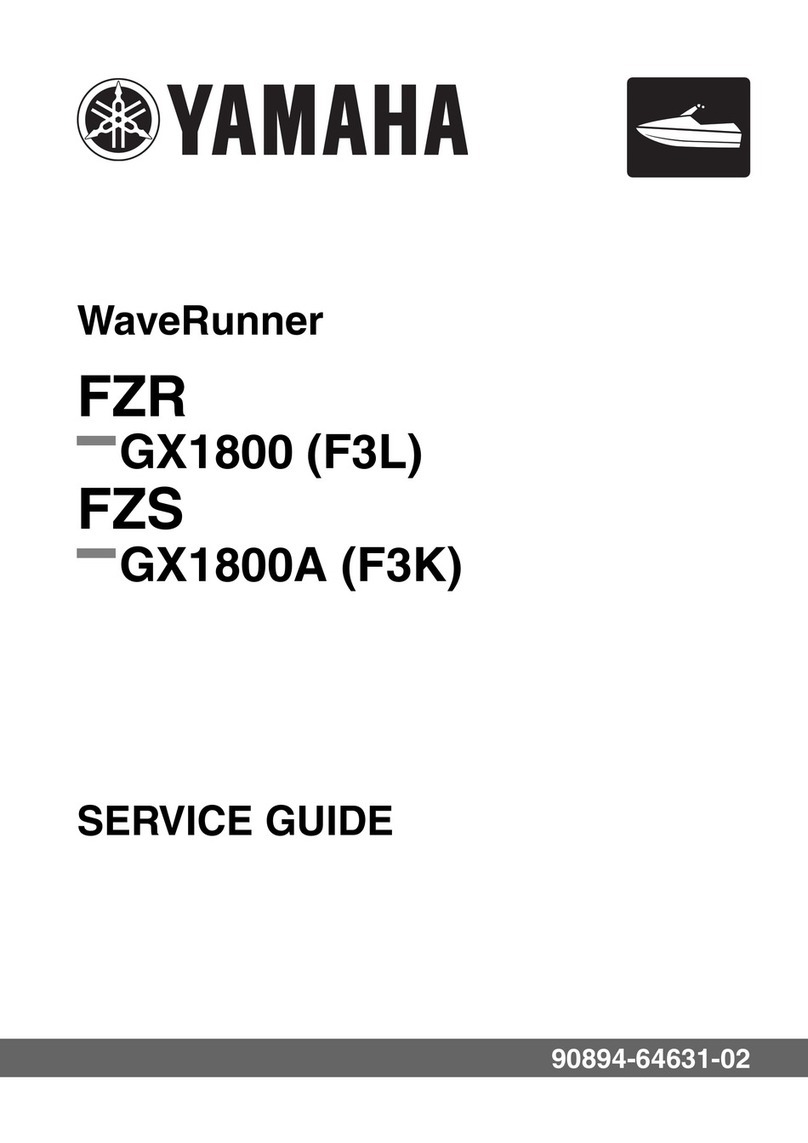
Yamaha
Yamaha GX1800A Service guide
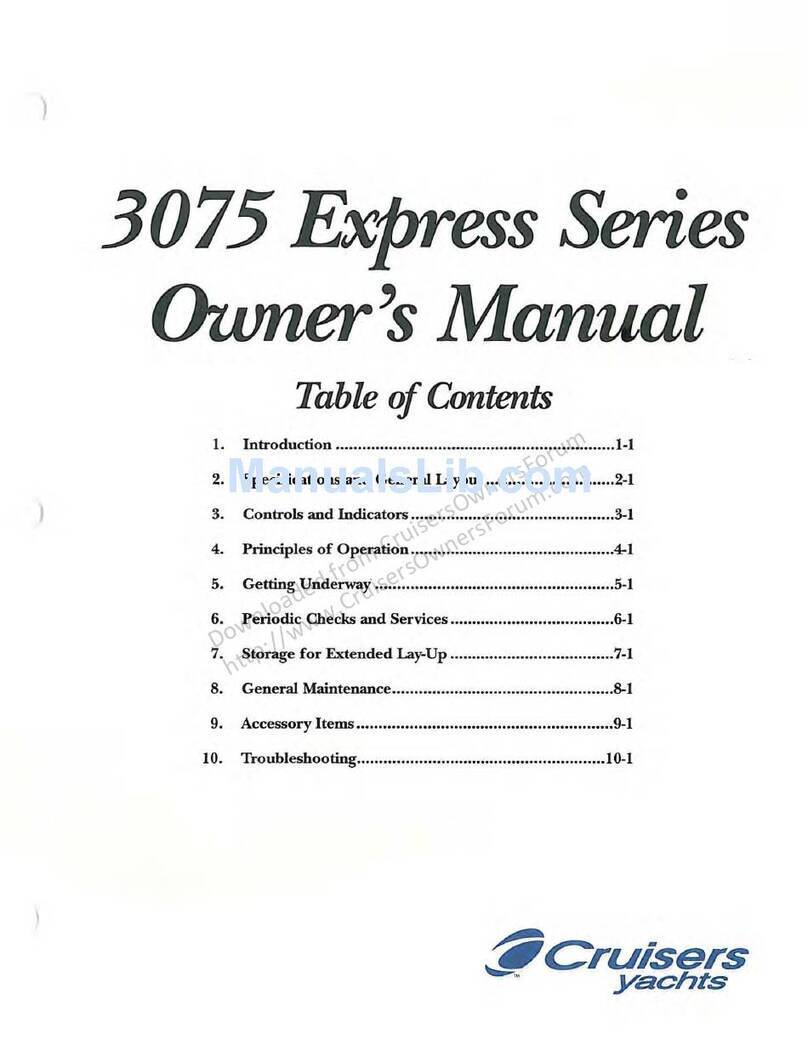
Cruisers Yachts
Cruisers Yachts 3075 Express Series owner's manual
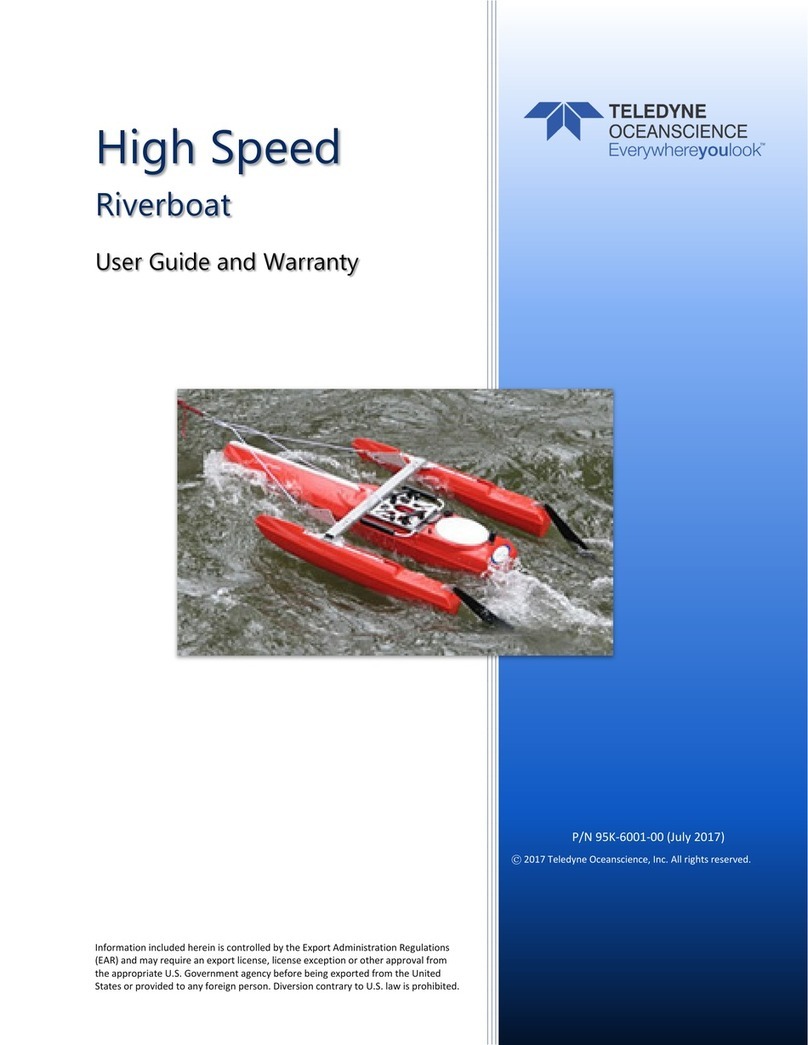
Teledyne Oceanscience
Teledyne Oceanscience High Speed User's guide and warranty

X-Yachts
X-Yachts X-99 Tuning guide
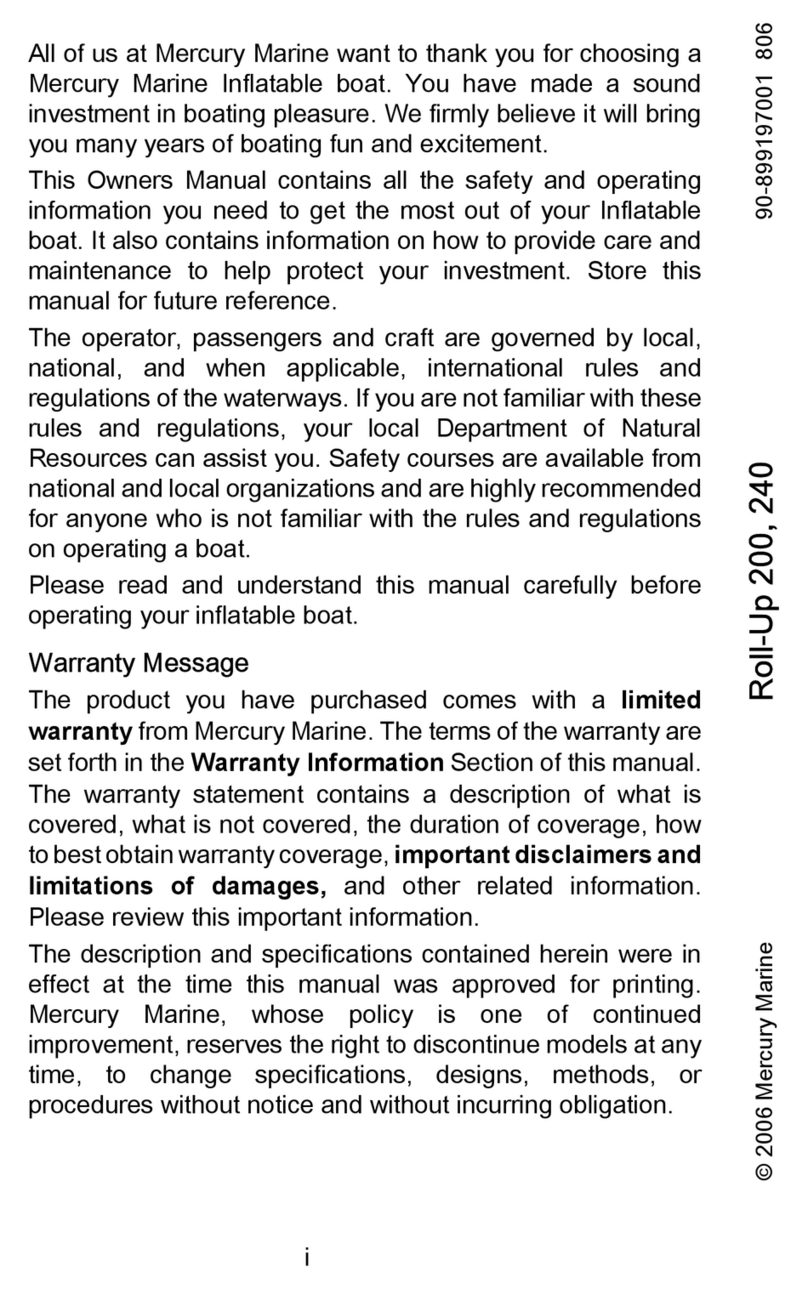
Mercury
Mercury Roll Up 899197001 owner's manual

